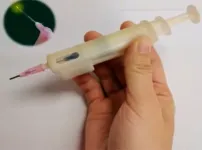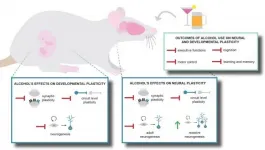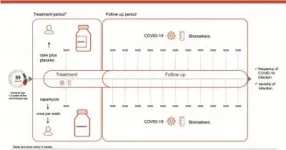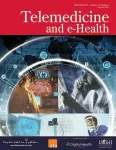'Handy pen' lights up when exposed to nerve gas or spoiled food vapors
2021-02-10
(Press-News.org) Exposure to some odorless, colorless and tasteless gases, such as nerve agents, can be toxic or even lethal. And having the ability to detect other types of vapors could save people from eating spoiled or rotten food. Easy-to-use portable devices could, therefore, go a long way toward protecting the public. Now researchers reporting in ACS Materials Letters have created a pen-like sensor that changes color when exposed to harmful gases.
Humans can't detect many toxic vapors, such as poisonous nerve agents or volatile amines released from spoiled foods, so a sensor that can notice these gases' very minute concentrations would be useful. Fluorescence-based sensors are a potential solution because they are inexpensive and can reveal trace amounts of compounds. However, some fluorescing compounds clump together once they react with gases, reducing their intensity, and they can require complex fabrication processes. Yet other fluorophores produce more intense light when they are clumped together -- aggregation-induced emission fluorogens (AIEgens). Most of the current detection methods using AIEgens are liquid-based, requiring gases to be dissolved in solution before analysis, and are not easily portable. So, Zhe Jiao, Pengfei Zhang, Haitao Feng, Ben Zhong Tang and colleagues wanted to adapt AIEgens to be integrated into a needle-thin fiber, creating a handheld device whose tip "turns on" in the presence of a particular gas.
The researchers developed two AIEgen-based "handy pens," one for identifying the nerve agent diethyl chlorophosphite (DCP) and the other for amines produced by rotting food. First, they coated silicon dioxide polymer fibers with a thin sol-gel layer to immobilize AIEgens. Next, they added an AIEgen that changes color when it reacts with DCP on one set of fibers, and an AIEgen that reacts with amines on another set. The coated fibers were then placed at the end of a pen-like device with a UV light source inside. The DCP sensor's tip changed from a yellow fluorescence to blue within 30 minutes of exposure to DCP. The amine sensor's tip was initially a mild blue-gray color, but it generated a vibrant yellow-colored light within five minutes when it was exposed to volatile amine vapors. Both sensors reverted to the original hue when exposed to neutralizing vapors, demonstrating that they were reversible. Finally, the team used the amine-responsive handy pen to distinguish between a salmon sample that had been refrigerated and one that had been left at room temperature for 48 hours. The researchers say that other handy pens could be easily developed by using different vapor-sensitive AIEgens, which could be applied to food safety, environmental monitoring or public safety applications.
INFORMATION:
The authors acknowledge funding from Science and Technology Planning Project of Guangdong Province of China, Educational Commission of Guangdong Province of China, the Social Science and Technology Development Project of Dongguan, Guangdong International Cooperation Project, the Science and Technology Plan of Shenzhen, the UNSW-CAS Collaborative Research Seed Fund Program and the Shenzhen Institute of Advanced Technology Innovation Program for Excellent Young Researchers.
The abstract that accompanies this paper is available here.
The American Chemical Society (ACS) is a nonprofit organization chartered by the U.S. Congress. ACS' mission is to advance the broader chemistry enterprise and its practitioners for the benefit of Earth and its people. The Society is a global leader in providing access to chemistry-related information and research through its multiple research solutions, peer-reviewed journals, scientific conferences, eBooks and weekly news periodical Chemical & Engineering News. ACS journals are among the most cited, most trusted and most read within the scientific literature; however, ACS itself does not conduct chemical research. As a specialist in scientific information solutions (including SciFinder® and STN®), its CAS division powers global research, discovery and innovation. ACS' main offices are in Washington, D.C., and Columbus, Ohio.
To automatically receive news releases from the American Chemical Society, contact newsroom@acs.org.
Follow us: Twitter | Facebook
[Attachments] See images for this press release:

ELSE PRESS RELEASES FROM THIS DATE:
2021-02-10
CHICAGO --- Northwestern University's Noshir Contractor will discuss team problem-solving and human systems integration for Mars exploration at the American Association for the Advancement of Science (AAAS) annual meeting.
At a AAAS press briefing at 12 p.m. ET, Wednesday, Feb. 10, Contractor will discuss recent findings and opportunities for social science research on astronauts as exploration advances into deep space. The embargo will lift at the time of the press briefing.
In addition, he will present "Pairing Teams for, and (Re)pairing Teams During, Long-Duration Space Exploration" at 1 p.m. ET on Thursday, Feb. 11 ...
2021-02-10
Political polarization is having far-reaching impacts on American life, harming consumer welfare and creating challenges for people ranging from elected officials and policymakers to corporate executives and marketers.
That's one of the conclusions of a new scholarly paper by researchers from the University of Wyoming and five other universities across the country. The paper appears in the Journal of Public Policy & Marketing of the American Marketing Association.
"I think we're all aware of how political polarization has affected our elections and system of government, but the impacts go far beyond the political arena," ...
2021-02-10
Oncotarget recently published "Evaluation of cancer-derived myocardial impairments using a mouse model" which reported that Myocardial damage in cancer patients is emphasized as a cause of death; however, there are not many murine cachexia models to evaluate cancer-derived heart disorder.
Using the mouse cachexia model that they established previously, the authors investigated myocardial damage in tumor-bearing mice.
When rat cardiomyoblasts were treated with mouse cachexia model ascites and subjected to flux analysis, both oxidative phosphorylation and glycolysis were suppressed, and the cells were in a quiescent state.
These results are in good agreement with those previously reported on cancerous myocardial damage.
The established mouse cachexia ...
2021-02-10
Amsterdam, NL, February 10, 2021 - Neuroplasticity, the remarkable ability of the brain to modify and reorganize itself, is affected by or in response to excessive alcohol, whether through individual consumption or exposure in the womb. It is now well accepted that the birth and integration of new neurons continue beyond development and into adulthood. New discoveries and insights on how alcohol impacts this and other plastic processes are discussed in " END ...
2021-02-10
10th of February, Wednesday, Hong Kong - Deep Longevity, a fully-owned subsidiary of Regent Pacific (SEHK:0575.HK), specializing in the development and the application of next-generation artificial intelligence (AI) for aging and longevity research, today announced the publication of an article in Lancet Healthy Longevity titled "The potential of rapalogs to enhance resilience against SARS-CoV-2 infection and reduce the severity of COVID-19".
While the pandemic continues to unfold, targeted therapeutic solutions for COVID-19 are still not established. The extremely rapid development of various vaccines as a preventative approach provides ...
2021-02-10
New Rochelle, NY, February 9, 2021--The rapid upscaling of a telemonitoring program in which health care providers performed daily telemedicine check-ins on COVID-19 patients faced a unique set of challenges. How these were resolved, and early outcomes are reported in the peer-reviewed journal Telemedicine and e-Health, Click here to read the article now.
"Kaiser Permanente's Virtual Home Care Program (VHCP) was able to rapidly establish a telemedicine-based program for the management of COVID-19 positive patients in the DC and Baltimore Metro regions. Preliminary data suggest that such a program may be effective ...
2021-02-10
Mini-Neptunes and super-Earths up to four times the size of our own are the most common exoplanets orbiting stars beyond our solar system. Until now, super-Earths were thought to be the rocky cores of mini-Neptunes whose gassy atmospheres were blown away. In a new study published in The Astrophysical Journal, astronomers from McGill University show that some of these exoplanets never had gaseous atmospheres to begin with, shedding new light on their mysterious origins.
From observations, we know about 30 to 50 percent of host stars have one or the other, and the two populations appear in about equal proportion. But where did they come from?
One theory is that most exoplanets ...
2021-02-10
Lung ultrasound, considered a simple method for diagnosing lung disease, can also help predict the clinical progression of severe COVID-19 patients, according to a study conducted at the University of São Paulo's Medical School (FM-USP) in São Paulo City, Brazil.
The principal investigator for the study was Heraldo Possolo de Souza, a professor at FM-USP and an attending physician at its teaching and general hospital, Hospital das Clínicas (HC).
The researchers applied an ultrasound examination protocol covering 12 lung regions in 180 COVID-19 patients undergoing treatment at HC. The results showed that the higher the lung ultrasound score, the greater the risk of admission to an intensive care unit (ICU), intubation, and death.
The study was supported ...
2021-02-10
Gulls are one of the main wild birds that act as reservoirs of Campylobacter and Salmonella, two most relevant intestinal antibiotic-resistant bacteria causing gastroenteritis in humans. Therefore, according to an article published in the journal Science of the Total Environment seagulls could act as sentinels of the antibiotic pressure in the environment.
The study was carried out by experts of the Faculty of Biology and the Biodiversity Research Institute (IRBio) of the University of Barcelona, and the Institute of Agrifood Research and Technology (IRTA).
Resistant bacteria to antibiotics represent a serious problem for human health and other species since they can harden the treatment ...
2021-02-10
BOSTON - How often a person takes daytime naps, if at all, is partly regulated by their genes, according to new research led by investigators at Massachusetts General Hospital (MGH) and published in Nature Communications. In this study, the largest of its kind ever conducted, the MGH team collaborated with colleagues at the University of Murcia in Spain and several other institutions to identify dozens of gene regions that govern the tendency to take naps during the day. They also uncovered preliminary evidence linking napping habits to cardiometabolic health.
"Napping is somewhat controversial," says Hassan Saeed Dashti, PhD, RD, of the MGH Center for Genomic Medicine, co-lead author of the report with Iyas Daghlas, a medical student at ...
LAST 30 PRESS RELEASES:
[Press-News.org] 'Handy pen' lights up when exposed to nerve gas or spoiled food vapors







